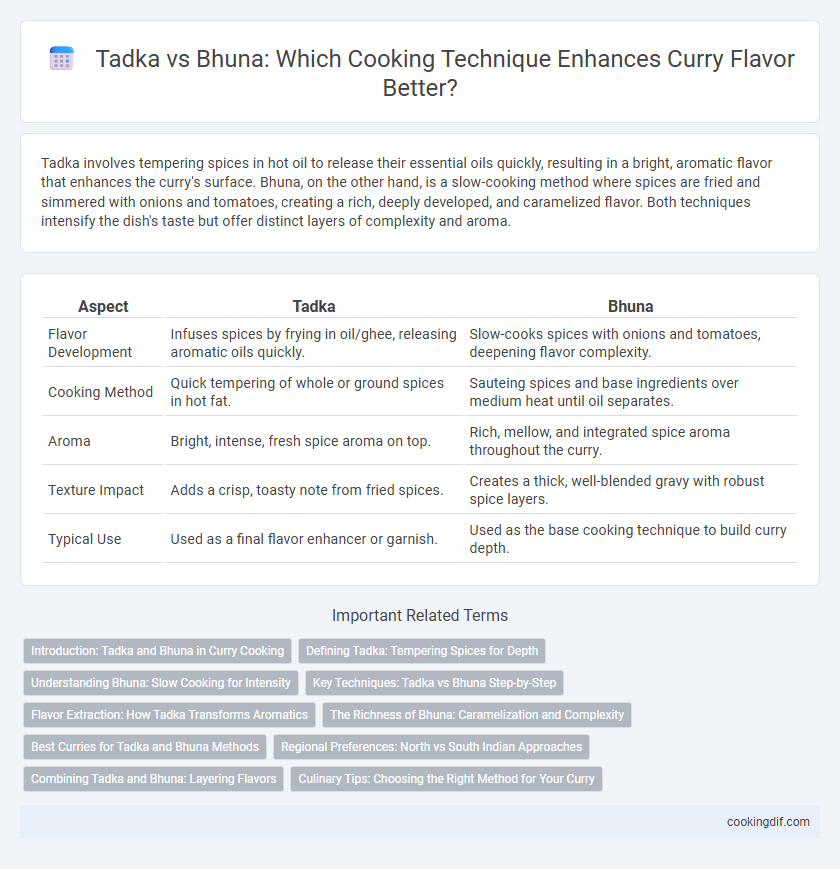Tadka involves tempering spices in hot oil to release their essential oils quickly, resulting in a bright, aromatic flavor that enhances the curry's surface. Bhuna, on the other hand, is a slow-cooking method where spices are fried and simmered with onions and tomatoes, creating a rich, deeply developed, and caramelized flavor. Both techniques intensify the dish's taste but offer distinct layers of complexity and aroma.
Table of Comparison
| Aspect | Tadka | Bhuna |
|---|---|---|
| Flavor Development | Infuses spices by frying in oil/ghee, releasing aromatic oils quickly. | Slow-cooks spices with onions and tomatoes, deepening flavor complexity. |
| Cooking Method | Quick tempering of whole or ground spices in hot fat. | Sauteing spices and base ingredients over medium heat until oil separates. |
| Aroma | Bright, intense, fresh spice aroma on top. | Rich, mellow, and integrated spice aroma throughout the curry. |
| Texture Impact | Adds a crisp, toasty note from fried spices. | Creates a thick, well-blended gravy with robust spice layers. |
| Typical Use | Used as a final flavor enhancer or garnish. | Used as the base cooking technique to build curry depth. |
Introduction: Tadka and Bhuna in Curry Cooking
Tadka and bhuna are essential cooking techniques in curry preparation, each enhancing flavor through distinct methods. Tadka involves tempering spices in hot oil to release aromatic oils that infuse the dish, creating a vibrant, fresh flavor profile. Bhuna requires slow cooking spices and ingredients until they form a rich, caramelized base, intensifying the curry's depth and complexity.
Defining Tadka: Tempering Spices for Depth
Tadka, also known as tempering, is a traditional Indian cooking technique where whole spices are briefly roasted in hot oil or ghee to release their essential oils and amplify flavor complexity. This method infuses the dish with a distinct aromatic depth, creating layers of taste that enrich curries and dals. Unlike bhuna, which involves slow-cooking spices with ingredients to develop a thick gravy, tadka acts as a finishing touch that heightens the overall sensory experience.
Understanding Bhuna: Slow Cooking for Intensity
Bhuna is a traditional cooking technique that enhances curry flavor by slow-cooking spices and ingredients over low heat, allowing oils and aromas to intensify gradually. This method caramelizes onions and spices, creating deep, rich, and complex taste layers that define authentic curries. Unlike quick tempering methods, bhuna's prolonged cooking ensures thorough blending and robust flavor development.
Key Techniques: Tadka vs Bhuna Step-by-Step
Tadka involves tempering whole spices in hot oil to release aromatic flavors instantly, often poured over finished dishes for a bright, fresh taste. Bhuna is a slow-cooking technique where spices and ingredients are fried together on medium heat until the oil separates, creating a deep, rich, and concentrated flavor. Mastery of tadka requires precision in timing and temperature, while bhuna demands patience and constant stirring to develop complex layers in curry sauces.
Flavor Extraction: How Tadka Transforms Aromatics
Tadka involves tempering whole spices in hot oil, rapidly releasing essential oils and intensifying aromatic compounds that infuse the curry with vibrant, layered flavors. This method enhances flavor extraction by creating a fragrant base that elevates the dish's sensory profile. Bhuna, in contrast, relies on slow-cooking spices and ingredients, resulting in deeper, melded flavors but less immediate aromatic impact compared to the dynamic burst achieved by tadka.
The Richness of Bhuna: Caramelization and Complexity
Bhuna cooking method enhances curry flavor through slow caramelization of spices and meat, creating deep, rich complexity. This process intensifies natural sugars and oils, resulting in a robust, layered taste profile unmatched by quicker methods like tadka. The richness of bhuna elevates curries with a thick, aromatic base that captivates the palate.
Best Curries for Tadka and Bhuna Methods
Tadka involves tempering whole spices in hot oil to release intense aromas, making it ideal for lentil curries like dal tadka and vegetable curries that benefit from a fresh, sharp spice profile. Bhuna is a slow-cooking technique where spices and ingredients are dry-fried to deepen flavors and develop a rich, thick gravy, perfect for meat-based curries such as lamb bhuna and chicken bhuna. The choice between tadka and bhuna depends on the desired curry texture and flavor intensity, with tadka offering vibrant, roasted notes and bhuna delivering robust, deeply concentrated tastes.
Regional Preferences: North vs South Indian Approaches
Tadka and bhuna techniques reflect distinct regional flavor profiles in Indian cuisine, with North Indian dishes favoring tadka for its layered, aromatic infusion of spices tempered in hot oil or ghee, enhancing rich gravies. South Indian curries rely heavily on bhuna, a slow-cooking method that intensifies spices and caramelizes ingredients to create robust, deep flavors integral to regional staples like sambar and rasam. These cooking methods showcase the culinary diversity, where tadka highlights vibrant spice bursts and bhuna emphasizes concentrated, hearty taste in curry preparations.
Combining Tadka and Bhuna: Layering Flavors
Combining tadka and bhuna techniques enhances curry flavor by layering complex aromatic profiles during cooking. Bhuna's slow frying of spices in oil develops deep, roasted notes, while adding tadka--a final tempering of spices--introduces fresh, vibrant bursts of aroma. This dual approach intensifies taste, creating a multidimensional curry with both richness and brightness.
Culinary Tips: Choosing the Right Method for Your Curry
Tadka, also known as tempering, involves quickly frying whole spices in hot oil to release their essential oils, resulting in a vibrant and aromatic flavor that is typically added at the end of cooking. Bhuna, on the other hand, means to saute spices and ingredients slowly over medium heat, allowing for deep caramelization and a rich, well-integrated flavor throughout the curry. Choosing tadka enhances fresh, sharp notes and is ideal for finishing, while bhuna builds a complex base, perfect for long-simmered curries.
Tadka vs bhuna for flavor development Infographic

 cookingdif.com
cookingdif.com